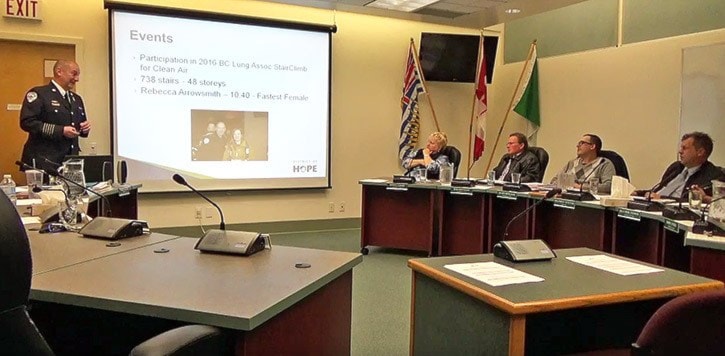Hope Fire Department fire chief Tom DeSorcy updated the District of Hope council at the Oct. 11 meeting about the status of the fire department.
DeSorcy noted that as a result of the new federal Protective Direction 36, DeSorcy now gets information of dangerous goods that pass through Hope from CN Rail.
“Every quarter, I get a report, and it tells me in confidence, which I can't share, of course, what goes through our town,” said DeSorcy.
According to the Government of Canada's website, the direction requires that railways include details like number of trains, volume and nature of the goods shipped, in specified reporting intervals.
With the new list of dangerous goods that passes through Hope, DeSorcy said he could “heighten the awareness and heighten the training, so we know what to expect.”
DeSorcy added that they have participated in a new training program called Exercise Vulcan, held March 12-13.
According to the Government of Canada's website, it trains firefighters to deal with train derailments. The program, still in its infancy, was started after the Lac-Mégantic incident that devastated the Quebec town.
DeSorcy also added that the Fire Department has also been working with Kinder Morgan and Spectra Energy to train firefighters on pipeline emergencies.
Upon questioning by Coun. Bob Erickson, however, DeSorcy revealed that the Fire Department firefighters are not trained to the hazardous operations level.
“They suggested to us that if the train goes through your communities, [somebody] in your community should be at that level,” said Erickson, referring to what he learned at the Union of B.C. Municipalities.
DeSorcy noted that the Fire Department is trained to a harzardous materials response (hazmat) awareness level, but to train to a higher level — hazmat operations or technician — would require a lot in both training and equipment.
“Having the awareness level is where we want to be, making sure we know how to identify product and know what to do with people that don't need to be around that product,” said DeSorcy.
This year, the Fire Department is also pursuing the creation of an Incident Support Unit. The unit helps firefighters by providing them auxiliary services such as clerical work on scene and rehabilitation of firefighters.
“We have targeted a few individuals that are going to lead the program and our fire department — older members that, of course, have the training and the understanding of command, understanding of radio language,” said DeSorcy. “We are working on protocol for our response and how we call these people out, getting pager tones developed.”
DeSorcy will accept new applications next year, and part of the training for the ISU personnel involves observing firefighter recruit training to experience and understand firefighting.
They currently have 30 members, recruiting four members this year. Out of those four, two of them have been trained to respond to calls, the other two “are almost there in terms of their training.”
A Fire Department member, Rebecca Arrowsmith, participated in this year's British Columbia Lung Association's Climb the Wall: The Stairclimb for Clean Air event, which challenged her to climb 738 stairs, or 48 floors, at the Sheraton Vancouver Wall Centre Hotel.
She finished that in 10 minutes and 40 seconds, making her the fastest female in her category while donning full fire gear.
“She wants to do better in 2017,” said DeSorcy.
This year, the Fire Department has 263 calls so far, which compares to 273 calls they had in 2015 up to Oct. 10. So far, fire damage has cost $515,000 in losses, DeSorcy estimates.
